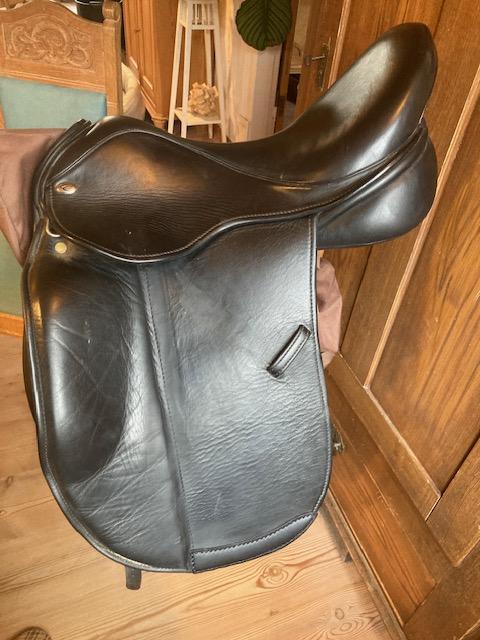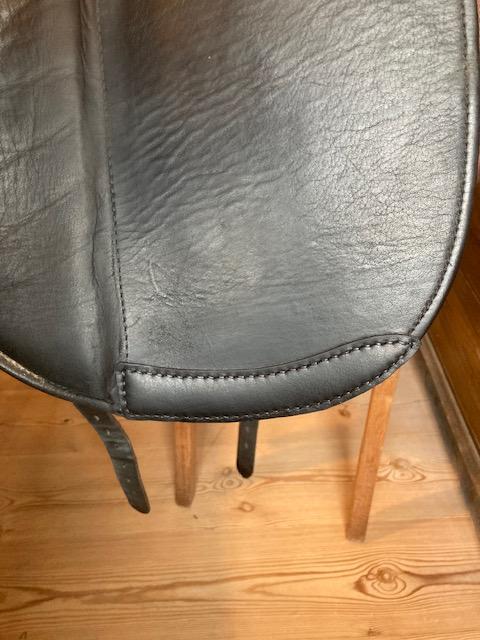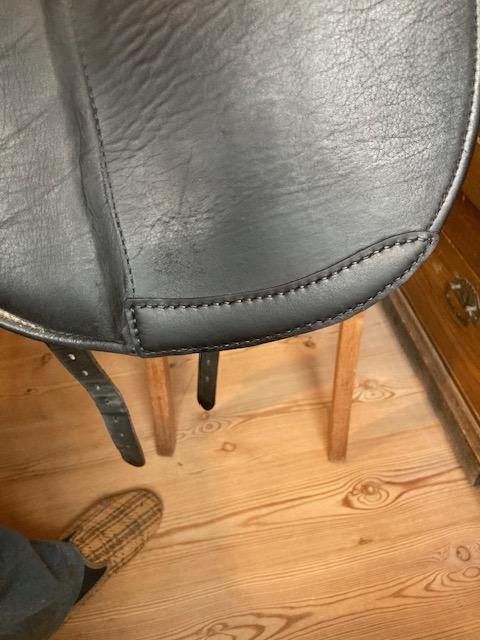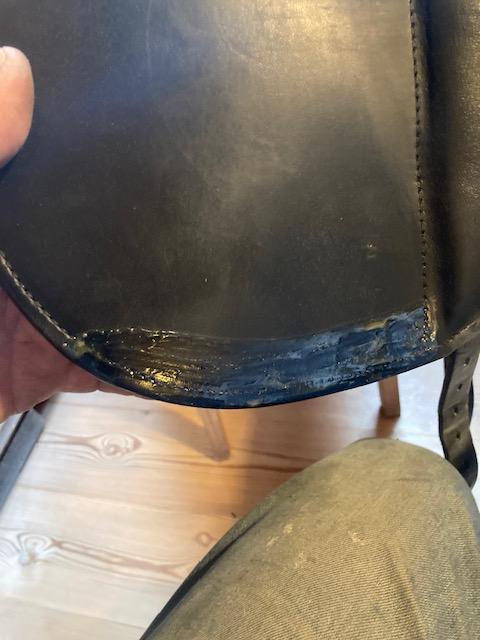-
Posts
762 -
Joined
-
Last visited
Content Type
Profiles
Forums
Events
Blogs
Gallery
Everything posted by Mulesaw
-
I have a 1967 Volvo L3315 Valp (meaning puppy), it is an ex Swedish military radio offroad vehicle. Sadly the Danish government is trying its best to make it difficult to drive classics or vintage cars. I also have a couple of vintage motorcycles. A 1962 Vespa GL 150 scooter, a 1973 Moto Guzzi V7 Sport and a 1978 Moto Guzzi Le Mans :-) Our youngest son has been bitten by the bug :-) and in the age of 18 forked out a wad of cash and bought himself a souped up 1962 Volvo 121 Amazon. IT still amazes me how it is possible to make such boring and bland cars today. I miss some curves on the body of vehicles. They all look very much alike those days.
-
ISO 1/2" stainless snap hook/halter snap
Mulesaw replied to TomE's topic in Hardware and Accessories
@TomE Yes it seems as though there is a bit of a rumble at the moment concerning tariffs.. I hope that you are able to get them without too much fuss. If all else fails, I'll be happy to order them and send them to you, but I guess it'll be the same result as Denmark and Czechia are both members of the EU. Another suggestion is to find a boat equipment dealer, They normally stock all kinds of things in stainless steel. It might be worth a try before unleashing the wrath of the import duty gods :-) -
ISO 1/2" stainless snap hook/halter snap
Mulesaw replied to TomE's topic in Hardware and Accessories
Pethardware in Czechia has got them. I tried to see Laederiet in Denmark, but they only got them in brass and this Zamak (zink alloy) https://www.pethardware.com/en/stainless-steel-snap-hook/stainless-steel-snap-hook-51mm-with-fixed-eye-2862/ I have ordered from them a couple of times and never had any problems. For some reason they list them according to total length, but just go for the eye width :-) They look a little bit different from the one you show, a bit more squarish in the shank, but that is the issue I can see. Brgds Jonas -
Beautiful work, looks almost too nice to use :-) I bet the customer is proud as a peacock when he/she is using them.
-
Skill Building for New Sewing Machine Owners?
Mulesaw replied to AEBL's topic in Leather Sewing Machines
I like to practice on off-cuts. They can have all sort of shapes, and putting two together and try to make a nice seam along the edge of one of the shapes is a great little exercise, and it only cost the thread. Brgds Jonas -
Really nice looking set. That knife would be a great EDC in my opinion. Hope the bidding goes high to help raise some funds.
-
If you are using the Tandy Horse tack accessory pattern pack, I just checked, and the sizes strike me as completely off. The upper part of the noseband alone for a full size horse, the pattern suggest a 24" strap. So I really don't think that you have done anything wrong at all :-) If you are making a halter for your own horse, try to take the measurements of an existing halter that has a nice fit. If it is going to be a gift for someone, go visit them in the stable and see if you can get a chance to measure the halter. Not knowing if you are a horse person, please be careful if you are going to do any measuring on the halter when it is on the horse. Some horses will happily accept that you measure a bit with a tailors measuring tape, others the exact opposite. So it is always best to measure stuff that is not directly on the horse. The patterns and instructions provided by Tom E are fantastic! I have made 4 halters using those patterns, and they fit the horses very well, and they look incredibly good. If you like the Tandy design, you could use Tom E's measurements and make a halter according to the Tandy pattern. That would get you something that will fit the horse. (Unless you are making it for a Shire / Suffolk Punch / Clydesdale). Brgds Jonas
-
Well thought out system! I was blown away by your collection of neatly organized stamps. I currently have 6 stamps, so there is still a long way to go for me :-)
-
Darn that looks good!! I feel like I cheated on my last belt using a sewing machine to make the stitching :-) Hand stitched just look better!. The copper/brass edging detail is really well thought out and executed. and the HF detail looks like it was glued on. Makins a silver soldering with nothing flowing out is not an easy task! I am going to take some of those Candian coins from the ship with me home, our own low value coins don't have any animals on them. I am looking forward to seing the finished belt. Brgds Jonas
-
They look incredible! Do you use them on belts for securing the buckle, or as ornamentation? Brgds Jonas
-
They look SO good!! What do you use for antiquing? I am getting tempted to try it out based on those beautiful conchos you just made. Brgds Jonas
-
@Veriye I think that as long as you choose a fairly standard saddle tree, you should be able to sell the saddle afterwards. As long as it is a hobby, it is OK that it cost some money. So even if you are not able to sell the saddle when it is completed, you have learned from building it, and you have hopefully had a good time doing it. it is nice if your hobby can generate a bit oncome to covers some of the costs, but since it is "just a hobby", that shouldn't be the major concern. If you look at someone who likes to go hunting as a hobby, they have to pay for the hunting area and for a gun and some equipment. They spend countless hours and perhaps come home with a deer once in a while, so if you calculated the price of meat compared to the number of hours spent or amount of money spent on equipment - it would be really expensive meat. But the meat is just a biproduct of the hobby, and I think you should see your saddlebuild as a "biproduct of your hobby" as well. Just make sure you have a good time doing it, and enjoy every moment of the build. It doesn't matter if you spend 600 Euros on materials. If that is a project that can keep you happy and occupied for a year it is well worth it. Good luck with the saddle build. Brgds Jonas
-
What leather craft has given me in life.
Mulesaw replied to Beehive's topic in All About Us and Off Topic
I think leather crafting is a great way to leave your mark on this world! Some of the dearest things are those that have been made to us by others and gifted to us. I can't really explain the feeling of connection, but I think it is something with the fact that whoever made this or that did it with their own hands and thought of us while they were doing it. So if you make something no matter how long it takes, and give it to either a friend or a family member, those items will bring back memories whenever used. It is good to have you here. Jonas -
@Joost Many people here (myself included) are sceptical in clicking on links. So if you can take a picture or two and post, it will probably generate a response. Plus it will make sure that the thread will still be meaningful in a couple of years since links tend to go bad over time, and a picture in the post will still work :-) I haven't looked at the video/link, but if the curve is tight, it can sometimes help to make some relief cuts in the fabric of the zipper. Just cut straight in from the fabric side and leave maybe 1/4" of fabric next to the teeth of the zipper. That is how it is done on e.g. riding boots that have the zipper down the front to make it able to follow the curve of the foot. Brgds Jonas
-
@TomEThanks Tom As usual I forgot to take some pictures of the saddle before starting the repair job. But as far as I remember, the reinforcement strips were completely worn through in the middle. On some of the saddles I get to repair, only part of the stitching is damaged by abrasion, and then I just restitch that part. I haven't made tack to sell. I doubt that I would be able to. I know that I can't complete on price, and that is just such an important factor for most people over here. So repair jobs make up for the bulk of our work. I would love to be able to sell a triple stitched halter, but for the same amount of money most people will prefer to buy a brand name halter. No complaining, it is just the way it seems to be :-) I do pretty much the exact same thing with tapering over 1.5 - 2" depending on the article to be repaired. Some jobs I manage to sew on the patcher, and I can see that most tack is machine sewn originally, so I do it to speed up the process and make sure that the customers don't think the repair job is too expensive. A reoccurring repair is the buckle straps that are attached to the noseband of the bridles. It is no wonder that they fall off. Often the strap is scarfed really thin, and then it is sewn across the thinned piece. So the slightest pull it will part on the stitch line. I really like to make repair jobs on leather items, there is something very satisfying in lengthening the lifespan of a piece of tack to me. And it sure beats repairing then inner lining of a damaged winter horse blanket. :-) Brgds Jonas
-
One of my clients had worn through the reinforcement on the lower part of the outer flaps on her Passier saddle. It is one of those damages that see fairly often. Mostly on dressage saddles. On this saddle I hand stitched on some reinforcements that were slightly beefier than the original very thin ones. The main cause of the wear on this saddle was inadequate cleaning. The client had oiled/greased the saddle very well, but riding in dusty conditions had caused the dust to mix into the grease that was left in the sewing and other nooks and crannies on the saddle. I tried to scrape of a bit and if I rubbed it between two nails, I could clearly feel that it was abrasive like carborundum. I started of washing the saddle really well, but technically I hadn't been asked to do that by the client, so I just did it on my own time to be nice since she is a good repetitive client. It helped some, but it could have needed an even more thorough cleaning. I was at a dilemma if I should tell her uninvited what I believed the cause was. I decided that if I was asked I would tell and show it, but otherwise I wouldn't. I would hate to sound condescending in case she did her best in cleaning already, and generally people (including myself) often get irritated if offered unsolicited advice. I really hoped that she would have asked, since I felt sorry about the fact that this damaged could have been lessened a lot with a rather simple job. @Goldshot Ron shared a great recipe for a simple cleaner: Water, ammonia, and a few drops of Ivory dish soap. I haven't tried it yet since I haven't had any saddles through my shop that required it lately, but it sounds like something that works really well, and equally important - it is a nice doable recipe without unicorn blood or ashes from volcanos as ingredients.
-
Leather lead with stallion chain
Mulesaw replied to Mulesaw's topic in Saddle and Tack Accessory Items
@Goldshot Ron Thanks Ron, I find that the problem with some of those saddle repairs is that my fingers itch to make a job, but the reality of the economics often prevents a correct proper job. I'd have do be completely sure that the customer would be OK with a hefty price, before starting on something really big. But the challenge of doing it is luring me like the song of the Sirens :-) @jcuk Thanks, this chain was the only one they had available at the local tack store. I got home from the ship on the 19th of December, so I had to make something fast for it to be ready for Christmas :-) Brgds Jonas -
Leather lead with stallion chain
Mulesaw replied to Mulesaw's topic in Saddle and Tack Accessory Items
Ouch.. No, those tears are for some weird reason not that common on the saddles that I have been tasked to repair. I would also not rely on glue to hold a patch there. And I would be afraid that If I attached a patch, it would sort of gnaw in your inner thigh, and probably cause a blister really quick, at least if the edge eventually fold over a bit. I think I might have repaired a similar tear once, but I don't think I ever took any pictures of it. It was a breaking in saddle, so it got a lot of beating, and they weren't that concerned about the looks. That one I repaired by making a baseball stitch. I didn't get any complaints about it, and it ended up looking fine. That would still be my suggestion for this saddle. It will blend in far better than a patch on the outside, especially if you find some light brown thread. Plus it is an inexpensive and fairly fast repair. You could use either curved needles or regular saddlers needles for the job, and a small awl to make the holes. Another alternative would be to cover the entire seat with a new piece. It would probably benefit from a bit of wet forming first. Next cut it out so it follows the original sewing line. This is then stitched to the stitching line. The new stitches should be stitched to the existing stitches, not through the leather (In an effort to make it as fast as possible) This would still be faster than replacing the seat, but I think it will be difficult to make it look really nice, and also getting a curved needle through every 2nd old stitch might not be a walk in the park. It is always a dilemma if the saddle can justifiably be repaired taken into account he price of a similar saddle with less wear. I picked up 2 tiny pony jumping saddles a couple of years ago with the intention of completely refurbishing them. Mostly to learn from the process such as methods and how long time this and that would take, and how difficult each operation would be. But I haven't found the time to get much further in that project. Over here, very few (if any) old English style saddles could bear a repair job that would be so costly. There are loads of old well used saddles to be had for a reasonable price. And most of the new and really expensive saddles just don't have those wear related damages. Good luck with the repair job. Brgds Jonas -
Leather lead with stallion chain
Mulesaw replied to Mulesaw's topic in Saddle and Tack Accessory Items
Hi Tom, I have repaired the lower part of the saddle flap, I think it might be the same repair job you are thinking of. (the lowest part of the saddle where the inside of the riders leg touches the saddle flap.) I'll try to see if I have some pictures of it. If I do have those picrures, I'll just make a new thread about it. Brgds Jonas -
Thanks, I used a small lunch plate as pattern, just marked around the circumference with a silver marker. I placed a square so both curves would start the same place. I had to try a few different plates first to find one that would give a nice looking curve. :-) Brgds Jonas
-
The engraving is not very deep, so I am not sure it would have stuck very well, but I see what you mean :-) I think that as soon as the buckle tarnishes a bit, it will stand out a bit more too. A very shiny surface for some reason seem to lessen the effect of the engraving (or it could just be lack of photographic skills :-) Brgds Jonas Thanks Tom Glad that I could spark a trip down memory lane. And thanks for the nice comments about the belt.
-
Leather lead with stallion chain
Mulesaw replied to Mulesaw's topic in Saddle and Tack Accessory Items
Hi Tom Patching a hole like that is something I do every once in a while. Here's my method: I take some thin leather of the correct colour - around 1 mm thick (2 oz), Make a paper pattern for the patch. The worn area tends to be kind of elliptical on the boots I have made. Trace the pattern on the boot and on the leather. Skive down the sides of your small patch over a width of 3/8" to very thin at the sides, to make a fairly seamless repair. Sand or rough inside the marking on the boot so the glue will stick. Maybe even wipe the area down with some thinner (some people drench their boots in oil). Apply contact glue to the patch and to the area on the boot. Press/hammer it in place when the glue is dry. Sew around the patch, I try to aim for 1/16" from the edge for the first round. Next make another stitching about 1/8" from your first stitch line. I just checked my phone, but for some reason I have never taken any pictures of those repair jobs. I can try to make an instruction with pictures in how I change a zipper. There are a few tricks that I have picked up along the way that have helped me. Brgds Jonas -
Repair of leather edge on Louis Vuitton bag
Mulesaw replied to Mulesaw's topic in Satchels, Luggage and Briefcases
Thanks, it is a bit daunting to repair a bag like that, but it really couldn't get any worse on the edge. So I braved myself and did it. Pig skin is really nice to work with I think. Brgds Jonas -
@Beehive I can see that those would look great on a buckle. I don't know where I'd get a doming block in Denmark.. It is strange, but some tools are just not quite as readily available over here compared to in the USA. But I guess I could turn a piece of hardwood to make the block, and then find a steel ball og something else to help me with the shaping. I just looked in my desk drawer here on the ship, and there are some Canadian coins, one with a caribou and one with a beaver. They could work I think. The Danish 50 øre (half a crown) is a copper alloy, around the size of a US nickel might work, but it is not very pretty. The Danish 1, 2 and 5 crowns look nice, they are silver coloured but the all have a hole in the middle, so I am afraid that would look strange. The 10 and 20 crowns are doubled in thickness and are brass coloured, they'd look good too if they weren't so thick. I think I see a coin doming experiment somewhere in the future :-) Brgds Jonas @jrdunn Thanks a lot :-) Brgds Jonas






